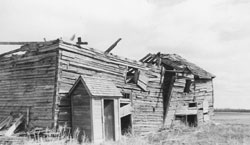Fort Mandan State Historic Site is temporarily closed for maintenance until further notice.
Gingras House
The Gingras house serves as testimonial to Gingras’s rise in affluence. Construction began in 1846, and by 1858 an addition was built. The house is actually a log cabin, but by 1860 Gingras had added clapboard siding and decorative “gingerbread” bargeboards.
 In 1858 Father Joseph Goiffon noted there was only one, one-and-one-half-story house in St. Joseph. In 1860, a St. Paul visitor reported there were only one or two clapboard-sided houses in St. Joseph.
In 1858 Father Joseph Goiffon noted there was only one, one-and-one-half-story house in St. Joseph. In 1860, a St. Paul visitor reported there were only one or two clapboard-sided houses in St. Joseph.
The fur trade era was a time of transition - the meeting of Native American and European cultures. Each group had something wanted by the other, and each received benefits from the exchange. With the establishment of European trading posts in the Pembina vicinity, some Chippewa Indians left their woodland homes in Minnesota, and settled in the prairies of the Red River Valley.
The fur trade flourished in this region for approximately a hundred years, with two peak periods of activity. The first was from the 1790s to the 1820s. Fur trade operations at that time were mostly extensions of British and French-Canadian operations such as the London-based Hudson’s Bay Company and the Montreal-based North West Company. Furs were transported east by canoe, and trade goods were brought west via the same water routes. During this period, beaver pelts were the main trade commodity.
 After 1822, fur trade activity slowed down in the Pembina region for a number of reasons, including over trapping and establishment of the 49th parallel as the boundary between Canada and the United States. The British Hudsons’ Bay Company, which had by then absorbed the North West Company, pulled back into Canada and abandoned it’s U.S. posts. European economy and changes in fashion and hat-making also contributed to the decline of the beaver fur trade.
After 1822, fur trade activity slowed down in the Pembina region for a number of reasons, including over trapping and establishment of the 49th parallel as the boundary between Canada and the United States. The British Hudsons’ Bay Company, which had by then absorbed the North West Company, pulled back into Canada and abandoned it’s U.S. posts. European economy and changes in fashion and hat-making also contributed to the decline of the beaver fur trade.
Pembina’s fur trade industry revived in the 1840s with the advent of the American Fur Camp and an emphasis on buffalo trade. Overland trade routes replaced the water routes, and St. Paul became the trading center. Each summer, commercial trains of Red River carts carried buffalo robes, pemican, and tallow to St. Paul, where they were traded for manufactured goods, guns, liquor, and grocery staples.
By the 1860s, the once vast herds of buffalo had disappeared, and the fur trade ended in the Red River Valley.
![]() Follow Gingras Trading Post State Historic Site on Facebook!
Follow Gingras Trading Post State Historic Site on Facebook!
Address:
1 1/2 miles NE of Walhalla
12899 105th ST NE
Walhalla, ND 58282
Get Directions
Hours:
Site grounds with outdoor interpretive signs open year-round.
Contact Gingras Trading Post:
phone: 701.825.6840
email: shspembina@nd.gov
Contact SHSND:
phone: 701.328.2666
email: history@nd.gov